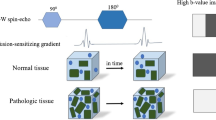Summary
Although carotid bifurcation stenoses are not the only lesions of the extracranial cerebral arteries, magnetic resonance angiographic (MRA) studies to date have concentrated on the carotid bifurcation. We compared digital subtraction angiography of the extracranial portions of the cerebral arteries with MRA using an ordinary body coil, the time-of-flight method, and multiple transverse slabs which covered the arteries down to the aortic arch. Twenty-two patients (15 with arteriosclerotic diseases, 4 with aortitis, and 3 with tumours) had MRA using a 1.5 T magnet system with a three-dimensional fast imaging with steady state precession (FISP) technique. Thirty-nine carotid and 39 vertebral arteries were assessed by three radiologists with regard to stenoses or occlusions, graded as normal, mild (<30%), moderate (30–60%) or severe (>60%) stenosis, or occluded. Grading corresponded well in 81%; stenoses appeared more marked on MRA in 14% and were seen less clearly on MRA in 5%. When 26 carotid bifurcations were assessed separately, grading corresponded well in 95%. MRA is the only method which can display the whole course of the extracranial carotid and vertebral arteries non-invasively and satisfactorily.
Similar content being viewed by others
References
Masaryk TJ, Modic MT, Ruggieri PM, Ross JS, Laub G, Lenz GW, Tkach JA, Haacke EM, Selman WR, Harik SI (1989) Three-dimensional (volume) gradient-echo imaging of the carotid bifurcation: preliminary clinical experience. Radiology 171: 801–806
Keller PJ, Drayer BP, Fram EK, Williams KD, Dumoulin CL, Souza SP (1989) MR angiography with two-dimensional acquisition and three-dimensional display. Work in progress. Radiology 173: 527–532
Pernicone JR, Siebert JE, Potchen EJ, Pera A, Dumoulin CL, Souza SP (1990) Three-dimensional phase-contrast MR angiography in the head and neck: preliminary report. AJNR 11: 457–466
Brown DG, Riederer SJ, Wright RC, Liu Y, Farzaneh F (1990) High-speed line scan MR angiography. Magn Reson Med 15: 475–482
Edelman RR, Mattle HP, Wallner B, Bajakian R, Kleefield J, Kent C, Skillman JJ, Mendel JB, Atkinson DJ (1990) Extracranial carotid arteries: evaluation with “black blood” MR angiography. Radiology 177: 45–50
Hass WK, Fields WS, North RR, Kricheff II, Chase NE, Bauer RB (1968) Joint study of exctracranial arterial occlusion. II. Arteriography, techniques, sites, and complications. JAMA 203: 961–968
Anderson CM, Saloner D, Lee RE, Fortner A (1990) Dedicated coil for carotid MR angiography. Radiology 176: 868–872
Author information
Authors and Affiliations
Rights and permissions
About this article
Cite this article
Furuya, Y., Isoda, H., Hasegawa, S. et al. Magnetic resonance angiography of extracranial carotid and vertebral arteries, including their origins: comparison with digital subtraction angiography. Neuroradiology 35, 42–45 (1992). https://doi.org/10.1007/BF00588277
Issue Date:
DOI: https://doi.org/10.1007/BF00588277




